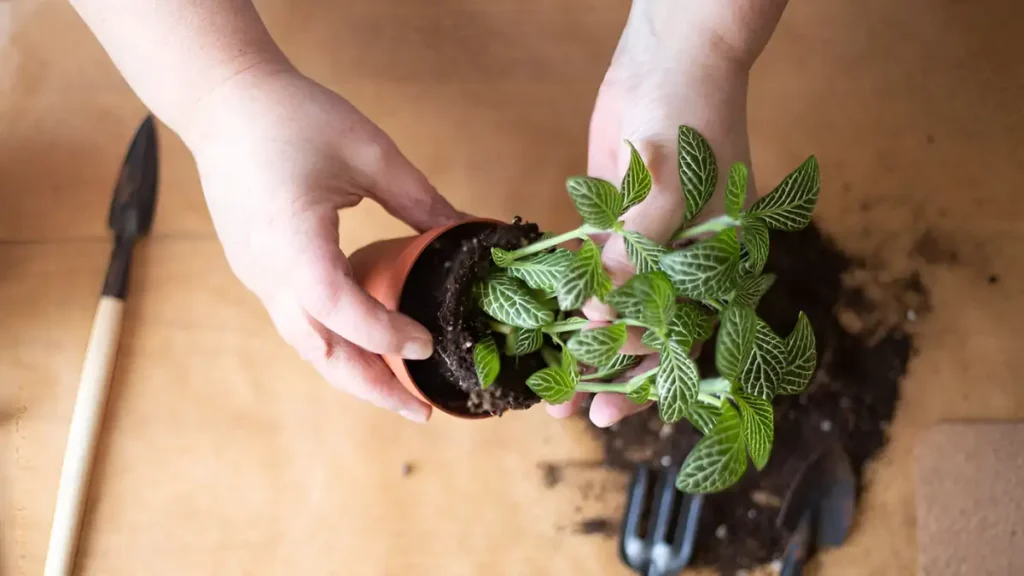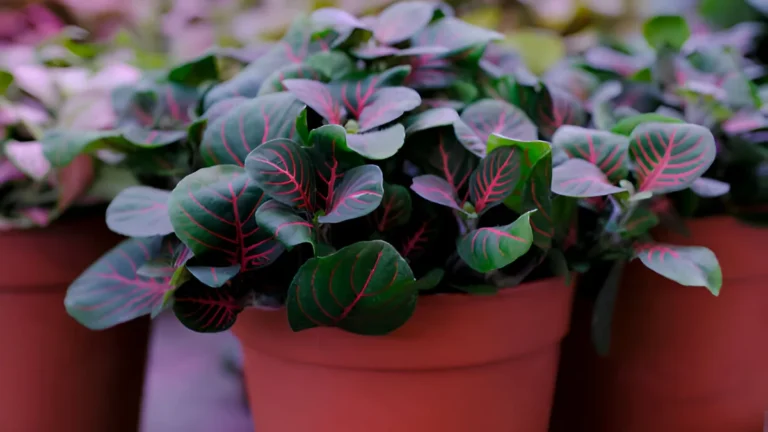Fittonia is a genus of flowering plants of the Acanthaceae family, also referred to as nerve plant or mosaic plant. It is known by the scientific name Fittonia albivenis. Native to South America, Peru, and Columbia’s jungles, the nerve plant is a tropical evergreen. It is perfect for restrooms and other damp locations because it enjoys high humidity and thrives in low to medium light levels. The plant may be grown as a creeping ground cover in areas with filtered sun if the conditions are correct. This section will go into great length about cultivating and caring for fittonia.
Everything about nerve plant Care:
Fittonia, despite its beauty, is a finicky and challenging houseplant to grow. It is necessary to spritz the plant frequently or set it in a tray with water and stones to maintain a high degree of ambient humidity and moisture levels for the plant.
Fittonia care
- Light:
It prefers bright, indirect sunshine, like that provided by windows facing north, and detests direct sunlight. Nerve plants thrive in additional humidity, so even with limited light, washrooms are excellent places to cultivate them. Fluorescent illumination works well for it.
- Soil:
Fittonia thrives on regular potting soil that has a peat moss foundation. Its ideal soil pH is 6.5, which is slightly acidic. In addition to having good drainage, the soil should hold onto some moisture.
- Water:
Fittonia requires constant moisture at all times. When the top inch of soil appears dry, water the plant. Excessive watering might cause root rot.
- Fertilizing:
Provide a small amount of liquid fertilizer designed for tropical plants to plants every four to six weeks during their growing season. Cut back on feeding in the winter and fall.
- Pruning:
When grown in the proper conditions, nerve plants grow swiftly. If the stems get lanky, prune them back to maintain a bushy appearance and promote new growth.

- Propagating fittonia plant:
Take an angled stem cutting in late spring or early summer, ensuring that it includes two nodes at least, to propagate your nerve plant. After potting the cutting, ensure the soil is damp but not soggy. Roots should start to appear in two to three weeks.
- Temperature and Humidity:
As nerve plants are indigenous to rainforests, dampness is a major attraction for them. A room humidifier could be useful in dry winter months or desert locations. Most cultivators discover that growing these gorgeous but finicky plants in terrariums or covered gardens, where they can receive the high humidity and soft light they adore, is the easiest way to raise these beautiful but finicky plants.
- Typical issues and their fixes:
Aphids, mealy bugs, and fungus gnats are examples of insects that cause issues. Treatment for infestations should begin right away. Neem oil or insecticidal soap should be applied directly on infestations.
Conclusion:
In conclusion, fittonia is comparatively simple to maintain, as long as it gets the proper humidity and water levels. It can be a pleasant addition to terrariums and is suited for tiny places due to its modest size. All things considered, Fittonia is a lovely and easy-to-care-for plant that can liven up any interior space with a pop of color. You can successfully create a fittonia garden if you adhere to the aforementioned criteria.
Certainly! If you’d like to learn more, please consider following our WhatsApp Channel: Harvest Gardening
A frequently asked questions:
Q1. Are fittonias toxic to cats?
A1. Fittonia does not poison cats, no. Cats can safely be around them.
Q2. How long do fittonias live?
A2. When given the right care, fittonias usually live for several years.
Q3. Why are my fittonia leaves turning yellow?
A3. The main causes of fittonia leaf yellowing are cold drafts, overwatering, and inadequate light. To avoid yellowing leaves, check the moisture content of the soil, make sure the plant receives indirect light, and keep it away from cold drafts.
Q4. Is fittonia an appropriate indoor plant?
A4. In bright indirect light, Fittonia performs incredibly well indoors. You can place the plant anywhere in the room as long as it doesn’t obstruct your view of the window if your room faces south or west.

